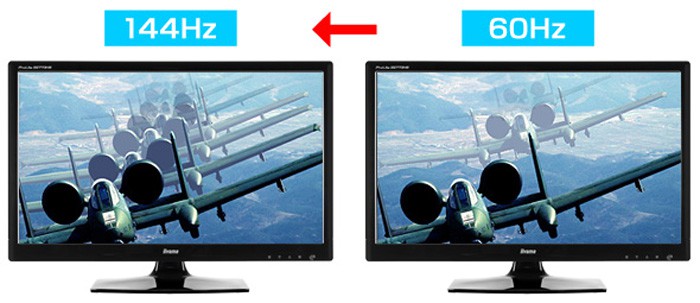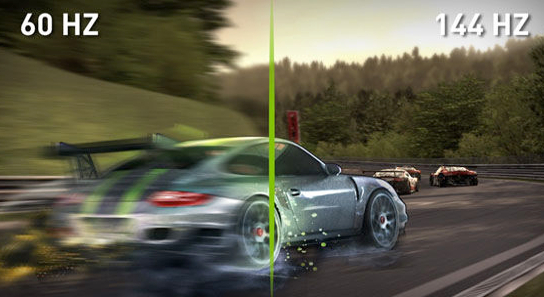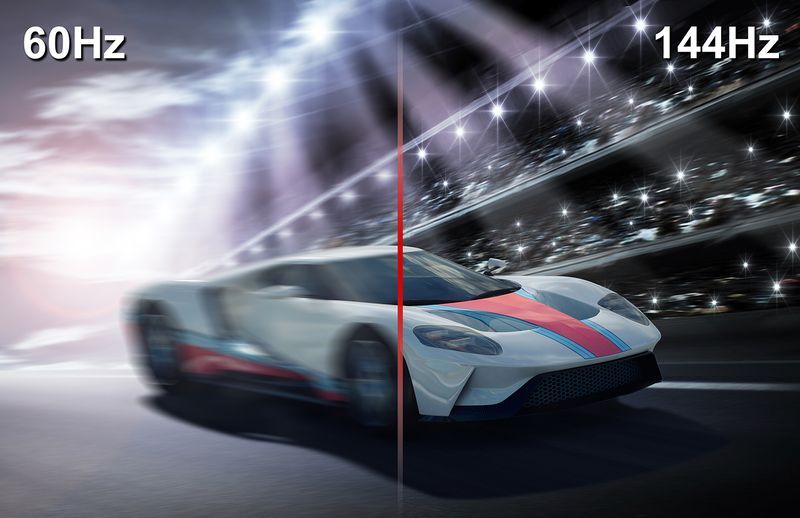What does 144Hz mean?
The refresh rate is the number of times a screen refreshes to display a new image. The frequency unit is Hz (hertz). Therefore, 144Hz means that the screen refreshes 144 times per second to display a new image, 120Hz means that the screen refreshes 120 times per second to display a new image, and so on.
With 120Hz, 144Hz, 240Hz and even 600Hz (Plasma TV only), the refresh rate gets a lot of attention in the marketing of HDTVs and computer screens.
What is it, will you ask me?
In fact, it is very simple.
Let’s start at the beginning because you will not understand the rest of this article if you do not know what the refresh rate basically means. Fortunately, the term is not so complex. The refresh rate is simply the number of times a screen refreshes the image it displays per second.
You can understand it by comparing it to the frame rate in movies or games.
If a movie is shot at 24 frames per second, the source content shows only 24 different frames per second. Likewise, a screen with a 60 Hz display frequency displays 60 “frames” per second.

It’s not really images, because the screen will refresh 60 times per second even if no pixel changes and the screen shows only the source that is provided. However, the comparison is still an easy way to understand the basic concept behind the refresh rate.
A higher refresh rate, therefore, means the ability to handle a higher refresh rate.
| Just remember that the screen only shows the source that is provided to it, and therefore a higher refresh rate may not improve your experience if your refresh rate is already higher than the frame rate. your source. |
144Hz refresh rate and game
All video games are rendered by computer hardware, regardless of their platform or graphics. Most of the time (especially in the PC platform), images are spat out as quickly as they can be generated because that usually results in smoother and more enjoyable gameplay. There will be less delay between each individual frame and therefore less entry delay.

A problem that can sometimes occur is when images are rendered faster than the speed at which the screen refreshes. If you have a 60Hz screen, which is used to play a game with 75 frames per second, you may be experiencing something called “tearing the screen”.
This occurs because the screen, which accepts GPU entries at regular intervals, is likely to catch hardware between frames. The result is a tear in the screen and jerky and irregular movements. Many games allow you to cap your refresh rate, but that means you are not using your PC to its full capacity.
What is the solution to this problem, you may be wondering?
A higher refresh rate. This means the purchase of a 120Hz or 144Hz computer monitor. These screens can handle up to 120 frames per second and the result is a much more fluid gameplay.

It also handles the lower V-sync like 30 FPS and 60 FPS, since they are multiples of 120 FPS. Upgrading from 60Hz to 120Hz or 144Hz is a very noticeable difference. This is something you only have to see for yourself, and you can not do it by watching a video on a 60 Hz screen.
The adaptive refresh rate, however, is a new advanced technology that is becoming more and more popular. NVIDIA calls it G-SYNC, while AMD calls it FreeSync, but the basic concept is the same. A screen with G-SYNC will ask the graphics card how fast it delivers the images and adjusts the refresh rate accordingly. This will eliminate the tear of the screen at any frame rate up to the maximum refresh rate of the monitor.
Watch 144Hz Videos
Watching a video is very different from playing a game, in terms of how the display shows you the content. A video is played from a source, while a video game is rendered in real-time. A movie is usually shot at 24 frames per second but is often converted to 30 FPS or 60 FPS by repeating some pictures.
Blu-ray discs played on a Blu-ray player, has the ability to produce 24 FPS. Such a low frame rate often causes flickering of the screen, so even in these cases, a higher frame rate is reproduced at a rate that reproduces the original 24 FPS movement.
Modern screens often operate at 60Hz or a multiple of 60Hz, which is why the frame rate is converted. YouTube, however, runs at 60 FPS, although YouTube has recently announced support for 60 FPS.
That’s why you do not really need a 120Hz, 144Hz or 240Hz display for video.
What about 600 Hz plasma TVs?
Sony X900H 65-inch TV: 4K Ultra HD Smart LED TV with HDR, Game Mode for Gaming, and Alexa Compatibility - 2020 Model
Features
- 4K HDR PROCESSOR X1: See premium 4K pictures, rich with real-world detail and texture. Upscale everything you watch to near-4K with 4K X-Reality PRO.
- TRILUMINOS Display: See exactly what the creator intended with advanced color and gradation.
- FULL ARRAY LED with local dimming: Brighter highlights and detailed dark scenes along with realistic contrast enhanced by X-tended Dynamic Range.
- GAME MODE: Take your PlayStation experience to the next level with a Sony 4K gaming TV featuring dedicated Game Mode for a smoother, more responsive gaming experience.
- HDMI 2.1: Get the most out of your next-gen gaming console with the latest HDMI 2.1 standards featuring ALLM, VRR and 4K at 120fps for reduced input lag, increased frame rate and ultra-smooth motion. (Firmware update required, available Winter 2020 and Spring 2021.)
Marketers often tell you that plasma TVs have a refresh rate of 600 Hz. That’s right, however, plasma displays work fundamentally differently from LCDs, so this has nothing to do with refresh rate mentioned in other technologies.
A plasma, to create an image, must activate and deactivate individual pixels extremely quickly. Usually, this is done ten times a second, and manufacturers multiply that by a typical 60 Hz rate to deliver the promised 600Hz.
Plasmas do not have movement problems, like the ghost, which is often a problem with LCD screens. This is because plasmas cool much more often than LCDs. Plasmas are, however, an endangered technology, so it does not really matter anyway.
Conclusion
Now that you know it still depends on whether or not you need a higher refresh rate, we’ll cover a few common scenarios.
- Games: You see a frame rate greater than 60 FPS, say 150 FPS, so yes, you will notice a big difference if you switch to a 120Hz or 144Hz computer monitor.
- Games: You do not see a refresh rate higher than 60 FPS or you have a V-sync capped at 60 FPS, so refreshing at a higher rate will not be beneficial.
- Watch videos: If you like very smooth videos, a display with a higher refresh rate will be beneficial if you install software that will interpolate images for your source.
- Watch videos: If you do not like the artificial appearance that image interpolation adds to the source, then a display with a higher refresh rate will not be beneficial to you.








